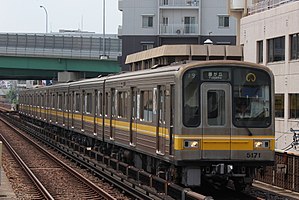Nagoya Municipal Subway 5050 series
Appearance
| Nagoya Municipal Subway 5050 series | |
|---|---|
 Nagoya Municipal Subway 5050 series set 5171 in July 2017 | |
| Manufacturer | Nippon Sharyo |
| Constructed | 1992–2000 |
| Entered service | 1992 |
| Number built | 162 vehicles (27 sets) |
| Number in service | 162 vehicles (27 sets) |
| Formation | 6 cars per trainset |
| Capacity | 680 |
| Operators | Transportation Bureau City of Nagoya |
| Lines served | Higashiyama Line |
| Specifications | |
| Car body construction | Stainless steel[1] |
| Car length | 15,580 mm (613 in) |
| Width | 2,546 mm (100.2 in) |
| Height | 3,440 mm (135 in) |
| Floor height | 960 mm (38 in) |
| Doors | 3 pairs per side |
| Maximum speed | 65 km/h (40 mph) |
| Acceleration | 3.3 km/h/s |
| Electric system(s) | 600 V DC |
| Current collector(s) | Third rail |
| Braking system(s) | Brake-by-wire regenerative braking air brakes |
| Safety system(s) | ATC, Train stop(Obsolete) |
| Track gauge | 1,435 mm (4 ft 8+1⁄2 in) |
The Nagoya Municipal Subway 5050 series (名古屋市交通局5050形) is a rapid transit electric multiple unit (EMU) train type operated by the Transportation Bureau City of Nagoya on the Nagoya Subway Higashiyama Line in Japan since 1992.
Specifications
Like other modern cars on the Nagoya Subway lines, the 5050 series uses a variable-frequency drive controller to convert DC current to AC current to power a squirrel cage motor.[1]
Formation
As of 1 April 2014[update], the fleet consists of 27 six-car sets, formed as follows.[1][2][3]
(Left is toward Fujigaoka Station and right is toward Takabata Station)
| Car No. | 1 | 2 | 3 | 4 | 5 | 6 |
|---|---|---|---|---|---|---|
| Designation | Tc1 | M2 | M1 | M1' | M2' | Tc2 |
| Numbering | 5150 | 5250 | 5350 | 5450 | 5550 | 5650 |
| Weight (t) | 21.4 | 25.2 | 25.2 | 25.2 | 25.2 | 21.4 |
| Capacity Total/seated |
96/32 | 107/40 | 107/40 | 107/40 | 107/40 | 96/32 |
One car is designated as a "women-only car" during the morning and evening peak periods on weekdays as a measure to reduce sexual assault during crowded times.[4]
References
- ^ a b c 5050形(東山線)の主要緒元 [5050 series (Higashiyama Line) technical details]. Rolling stock guide (in Japanese). Transportation Bureau City of Nagoya. Retrieved 16 November 2010.
- ^ 私鉄車両編成表 2014 [Private Railway Rolling Stock Formations - 2014] (in Japanese). Japan: Kotsu Shimbunsha. 24 July 2014. p. 95. ISBN 978-4-330-48414-3.
- ^ 私鉄車両編成表 私鉄車両編成表 2010 [Private Railway Rolling Stock Formations - 2010]. Japan: JRR. August 2010. p. 86. ISBN 978-4-330-15310-0.
- ^ 女性専用車両 [Women-Only Cars]. Information (in Japanese). Transportation Bureau City of Nagoya. Retrieved 15 November 2010.
External links
Wikimedia Commons has media related to Nagoya Municipal Subway 5050 series.

